Art & Exhibitions
London’s Dazzling ‘Big Bang Data’ Exhibition Reveals the Ugly Truths of Our Digital Lives
The show where you could run into your own selfie is here.
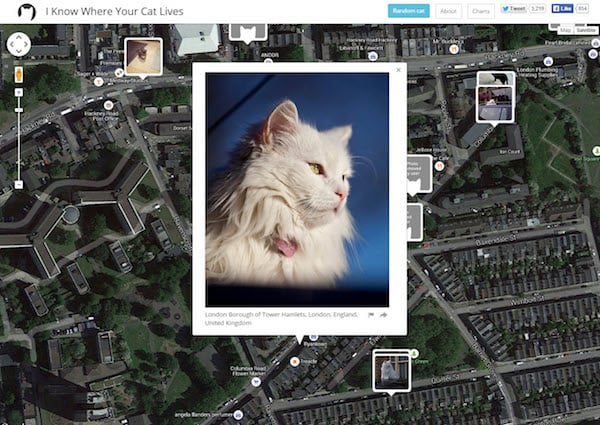
Photo: © Owen Mundy
The show where you could run into your own selfie is here.

Matilda Battersby

The group exhibition “Big Bang Data,” which opens today at London’s Somerset House, is all about selfie-expression. It takes the reams of unseen numbers, words, and images that modern humans toss carelessly in our wake and puts them under a big spotlight.
The subtext is part compliment, part criticism: namely that if you look hard enough at this show you might find something of yourself (perhaps even your face) in it; but watch out because the fact that this data exists means you’ve been flagrantly squandering it.
The shows takes the 2.5 trillion bytes of data produced by humans everyday as a starting point for examining how the world is changing as a result of the so-called “Big Bang” of data which happened in 2002, with the proliferation of sensors, smart devices, and everyday online activity.
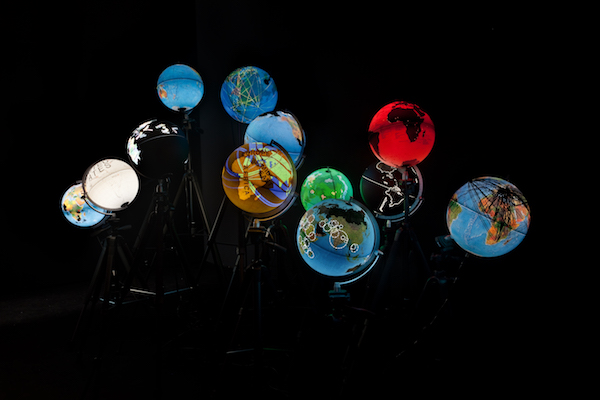
Ingo Günther, World Processor (1989 – 2014).
Photo: © ingogunther.com
The idea is a neat one, skilfully meshing the apparently opposite disciplines of science and art, while providing opportunity for both visual feast and serious sociological and historical analysis.
The latter is important because all the works here, however beautiful or linear-seeming, are entrenched in human behaviours, so they have an added weight. The map of undersea cables might look like an attractive piece of someone’s imagination, but it is something that sight unseen links us all and which we take for granted.
Already 120,000 people have visited the “Big Bang Data” exhibition when it was previously on show in Madrid, Barcelona, and Buenos Aires. The curators have done well to translate this interactive digital exhibition for the winding, old fashioned space of Somerset House’s Embankment galleries, even if the resulting effect is much more Science Museum than Tate Modern. But, like the data it contains, the exhibition has morphed and spiralled over time, and this is apparently now a very different show and includes a number of newly commissioned pieces.

Installation view of “Big Bang Data.”
Photo: Peter Macdiarmid Courtesy Somerset House.
Most striking of these is London Wall (WC2) by digital art duo Thomson & Craighead. Specially commissioned for this show, its floor-to-ceiling screens republish a series of tweets and other social media updates posted within a one mile radius of Somerset House. Which means that if you Instagrammed something ten minutes ago up the road you might find yourself looking at it on an epic scale when you reach the exhibition venue.
London Wall is far more impressive than the work of one of the most famous “social media thieves,” Richard Prince, who tests the bounds of copyright by “borrowing” and “repurposing” photos and then selling them for hundreds of thousands of dollars. But Thomson & Craighead’s piece is arguably a new platform through which to filter social media data, rather than an artwork that is staking claim to and stealing such updates. It is hugely effective, but nevertheless uneasy-making. Which is probably the point.
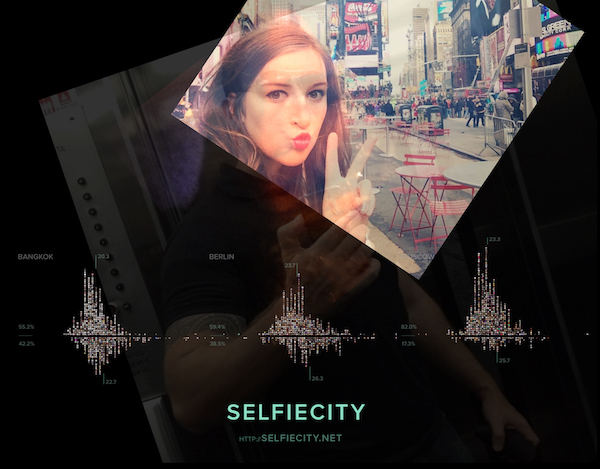
Selfiecity collage.
Photo: © selfiecity.net
Londoners might be less inclined to celebrate another of the show’s highlights, the selfiecity London project, which had some slightly unflattering findings for the capital’s selfie-snappers. Analysis of thousands of Instagram photos taken in central London in September, and compared to a similar tranche in five other big cities, reveals that Brits are older, more miserable, and more likely to wear glasses than our foreign counterparts. Yeah, thanks for that, “Big Bang Data.”
My favourite installation was Black Shoals: Dark Matter by Joshua Portway and Lise Autogena, a domed planetarium with beanbags underneath that you can lie on. The stars you gaze up at are actually a live representation of the world’s stock markets slowly moving across the black sky, forming constellations. Now, I’ll admit I’m not very business-minded, but the FTSE has never seemed so lovely.
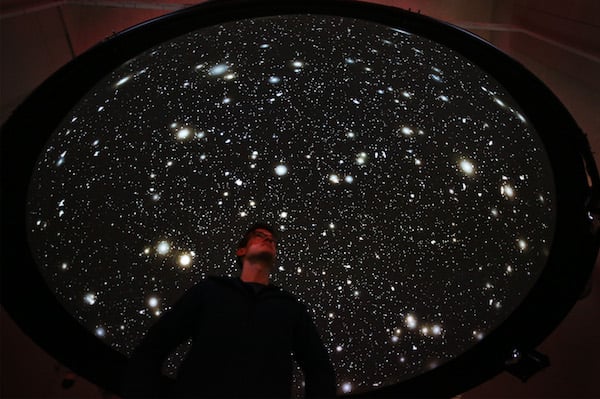
Installation view of “Big Bang Data.”
Photo: Peter Macdiarmid Courtesy Somerset House.
Also of note was Ryoji Ikeda’s data.tron [WUXGA version]—a Matrix-like video installation of regimented lines of changing data from floor ceiling which look at first glance, like white noise on a television set. The mesmeric movement of numbers is accompanied by an echoey soundtrack punctuated shrilly by beeps that sound like an iPhone on helium. If the artist’s intention was to draw our attention to the bamboozling nature of technology that we’re now so used to we don’t notice anymore, then this piece was a success. But frankly, looking at it made me feel ill.
The breadth the exhibition, covered via an eccentric mixture of art installations and scientific analysis, includes all sorts from surveillance, from the use of data for the common good such as in activism and politics, to the risk of “data-centrism” (warning us that the answers don’t always lie in data). Elsewhere, there were almost comical exhibits (for those of us over 30) such as floppy disks, cassette tapes, and CDs placed under glass domes, like rare specimens of a bygone era.
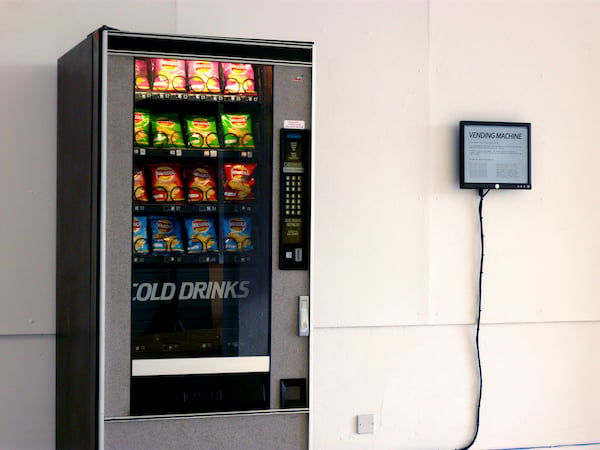
Ellie Harrison, Vending Machine (2009).
Photo: © Ellie Harrison.
All told, it was something of a whirlwind glimpse at a set of very complex and exciting ideas. I could have spent all day there, and I suspect some people will. It also made me look with new eyes at the selfie-stick wielding tourists ice skating at the front of Somerset House. Strongly recommended.
“Big Bang Data” is on view at London’s Somerset House from December 3, 2015-February 28, 2016.